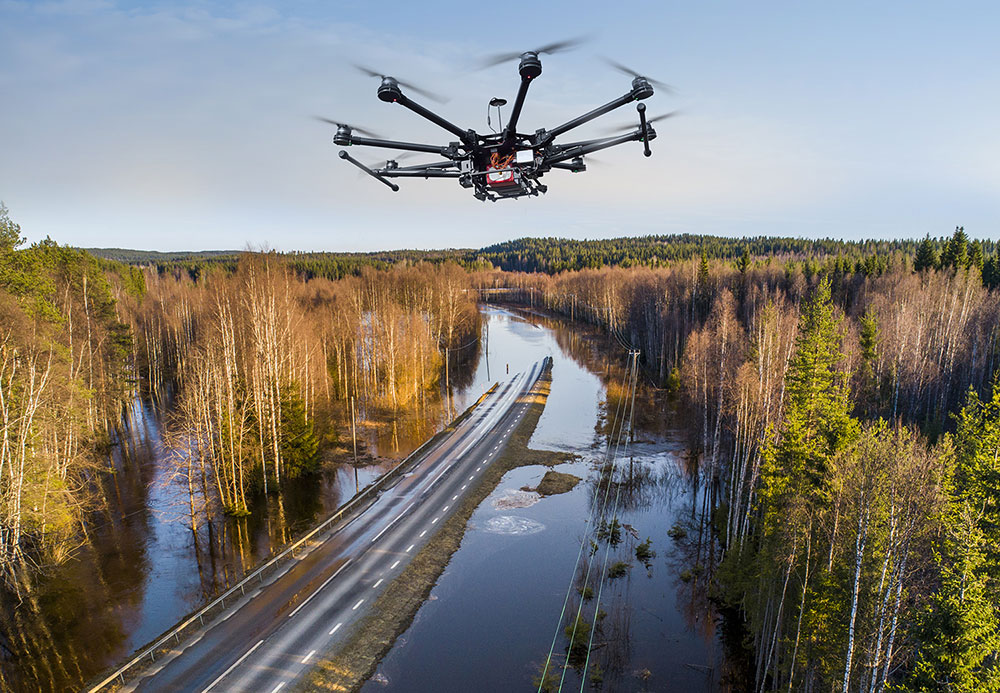April 2, 2020
Innovation of the Month:
Unmanned Aerial Systems
Unmanned aerial systems (UAS), or drones, are multi-use aircraft controlled from a licensed operator on the ground. UAS are used by transportation agencies around the country to enhance many aspects of highway transportation operations—replacing boots on the ground, increasing accuracy, speeding up data collection, and providing access to hard-to-reach locations.
Agencies use UAS to produce high-quality survey and data mapping, provide support for emergency response events, supplement labor intense activities such as bridge safety and construction inspections, and more. UAS allow States to obtain quality data to make better-informed decisions, all collected from a relatively low-cost platform. In short, the UAS business cases are revolutionizing the transportation industry.

Benefits:
- Safety. Keeping workers out of harm’s way is a major benefit of UAS. Traditional inspection methods can require setting up temporary work zones, detouring traffic, and using heavy equipment.
- Accelerated Construction. UAS technology can accelerate the rate of data collection operations, such as survey or aerial photography, and facilitate exact quantity calculation and efficient payment to contractors. UAS can be used for routine inspections, such as flying a programmed path over silt fencing after a rain event to check for sediment buildup, and high-risk inspections, such as crane or falsework construction.
- Asset Maintenance. The ability to routinely and consistently map terrain offers the potential for isolating problem areas before an emergency occurs, which can save lives and reduce costs for asset maintenance. In an emergency event, UAS technology can quickly and inexpensively survey the damage, allowing for better-informed and efficient recovery operations.
Over the next four weeks, you will read examples of how agencies use this innovative tool to improve efficiency, effectiveness, and reduce costs. To learn more about UAS and how they are changing the way transportation agencies do business, visit FHWA's UAS website or watch the UAS orientation webinar. If you would like to learn how to deploy UAS in your agency, please contact James Gray or John Haynes with the EDC-5 UAS team.
EDC Outtakes – Unmanned Aerial Systems
In EDC Outtakes—a series of short interview videos—State practitioners and FHWA personnel give insight into the current round of EDC innovations. In our latest edition, Robin Murphy, Director for the Texas A&M University Robot Assisted Rescue Center, discusses several benefits of using unmanned aerial systems, including some specific cost savings agencies have seen.
Keep reading EDC News for future editions of EDC Outtakes!
EDC-5 Progress Report Available
The Every Day Counts Round 5 Progress Report #2 is now available. This report describes the 10 technologies and practices FHWA is promoting in EDC-5 and summarizes the deployment status of each innovation as of December 2019 and each innovation’s goal for adoption by the end of 2020.
Has your State institutionalized unmanned aerial systems or used modern communication techniques through virtual public involvement? Is it bringing its A-GaME on subsurface exploration or STEP’ing up on pedestrian safety? Read the report to find out which States are implementing EDC-5 innovations and stay tuned to EDC News for updates and success stories.
About EDC
Every Day Counts, a State-based program of the Federal Highway Administration’s Center for Accelerating Innovation, works with State, local, and private sector partners to encourage the adoption of proven technologies and innovations to shorten and enhance project delivery.



